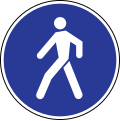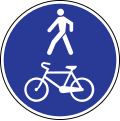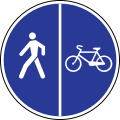For Latvia.
Do you make a distinction if a way is “Designated for cyclists and pedestrians” and “Designated for pedestrians, but cyclists are allowed”?
Technically, yes, but there aren’t any actual examples of the latter. I have personally never seen the “pedestrians only” sign altered with a “but bicycles allowed” modifying sign like the OP’s example, because this normally would simply be signed as a shared unsegregated cycleway or more likely just not signed at all (or signed against vehicles). As far as I know, they don’t exist in the real world (of Latvia).
For context, Latvia has pretty much 4 variants with these implications:
 -
- foot=designated, bicycle=no
 -
- bicycle=designated, foot=no
 -
- foot=designated, bicycle=designated, segregated=no
 -
- foot=designated, bicycle=designated, segregated=yes
Everything else that is unsigned allows bicycles by default (traffic law doesn’t forbid cycling anywhere except for specific exceptions).
Our tagging guidelines list these and all the other common scenarios here: https://wiki.openstreetmap.org/wiki/Lv:Latvian_tagging_guidelines#Veloceļi_un_veloinfrastruktūra
Now, theoretically, the white additional info sign could alter pretty much any traffic sign with pretty much any condition:
 (this could have text like “except bicycles” or “only on weekends”, etc.)
(this could have text like “except bicycles” or “only on weekends”, etc.)
But this seems more like a hypothetical scenario than a practical one.
Should StreetComplete offer both “Designated shared-use path” and “Footway, but a sign allows cycling” in your country, or should one of them be removed to avoid confusion?
In conclusion, I don’t see the point of “Footway, but a sign allows cycling” in Latvia if it just takes up UI space in SC, because this sort of signage is not used (although theoretically possible). If this variant is included, then theoretically any sort of combination of “For xxx, but sign allows xxx” is possible.